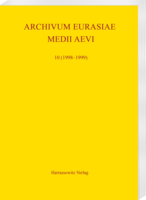|
Download:
The focus of Archivum Eurasiae Medii Aevi is on the political, social, economic and linguistic history of the peoples of the Eurasian steppes and adjoining regions from late antiquity to the Mongol Empire and its successor states. Among its primary concerns are questions regarding the Iranian steppe peoples, the Huns, the Oghur and Bulghar Turkic peoples, the Sabirs, the Avars, the Khazars and other peoples of the Türk Empire, the Hungarians, Pechenegs, Cumans and peoples of the Mongol Empire. The periodical will also touch on many points in the history of the Slavic world, Crimea, Byzantium, Iran, the Caucasus, the lands of Islam and the peoples of Central and Northern Europe, as well as elucidate various questions of Turkic and steppe history.
Aus dem Inhalt/From the contents: - N. Berend: Imitation Coins and Frontier Societies: The Case of Medieval Hungary - F. Curta: Iron and Potlatch: Early Medieval Hoards of Implements and Weapons in Eastern Europe - M. Goldelman: On the Location of the Khazarian City of Al-Bayda - P. B. Golden: The Nomadic Linguistic Impact on Pre-Cinggisid Rus' and Georgia - Ch. J. Halperin: The East Slavic Response to the Mongol Conquest - A. P. Martinez: Ducats and Dinars (Part I): Currency Manipulations, Paper Money, Arbitrage, the India Bullion Trade, and Monetary-Commercial Policy in the Il-Xanate - Th. S. Noonan: The Khazar-Byzantine World of the Crimea in the Early Middle Ages: The Religious Dimension |






